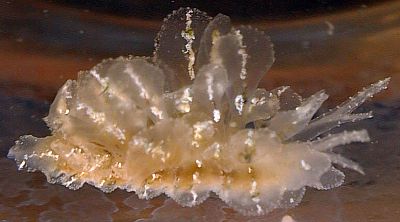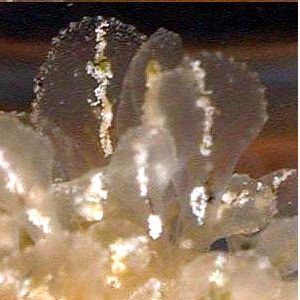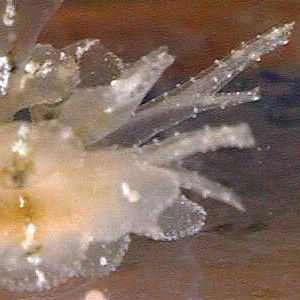Polybranchia orientalis from American Samoa
September 22, 2001
From: Don Barclay

Hello Bill,
Here are a couple of photos of what must be Cyerce elegans. I gave this one a good probing, but couldn't find a trace of the blue spots that are supposed to be characteristic of the species. Most of the cerata had green dendritic-looking structures inside, usually about the middle of each ceras, along with the opaque white branches. The photos show this to some degree, but I had a tough time getting it to really stand out.
Collected early afternoon of 3 August 2001, on algae-covered slab in main surge channel west of the small island, west end of Sailele village, northeast Tutuila, American Samoa. Water 1m deep, animal length 20mm.
Cheers,
Don Barclay
n5ols@samoatelco.com


Dear Don,
The reason this looks quite like the relatively transparent Cyerce elegans is that it hasn't had a feed for a while. The specks of green are the last traces of its food, and the branches you mention are branches of the digestive gland which are found in the cerata of Polybranchia but not Cyerce. In the two lower photos I try and show some of the digestive gland branching (LOWER LEFT) and the bifurcating rhinophores (LOWER RIGHT) which are characteristic of the family Caliphyllidae.
I am pretty sure this is a hungry Polybranchia orientalis.
Best wishes,
Bill Rudman
Related messages
-
Is this poisonous? I think i was stung.
From: Leigh Maulson, May 5, 2006 -
Polybranchia orientalis? from the Red Sea
From: Binyamin Koretz, May 5, 2006 -
Polybranchia orientalis from Singapore
From: Lim Han Peng, July 5, 2005 -
Sacoglossa from the Philippines
From: Erwin Koehler, April 19, 2002 -
Polybranchia orientalis from eastern Australia
From: Grey McNeil, July 5, 1999 -
Cyerce and Polybranchia
From: Bill Rudman, July 5, 1999
